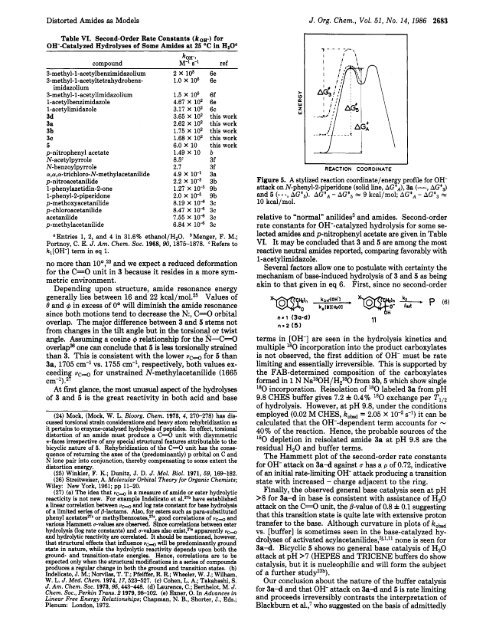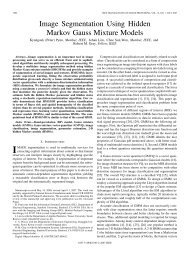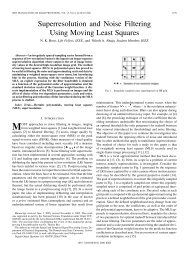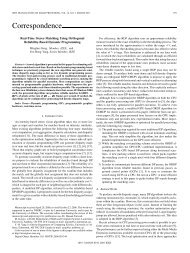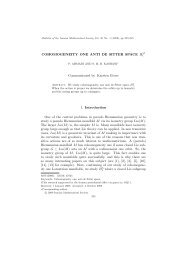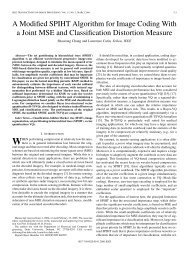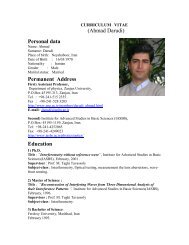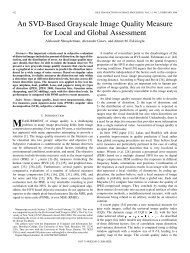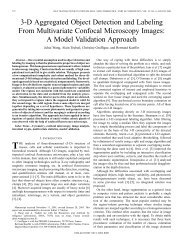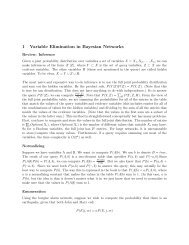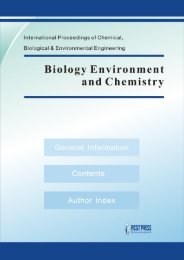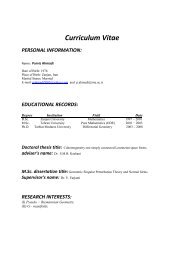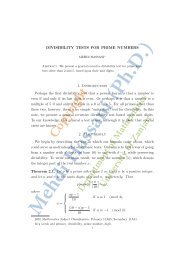Org. Chem. 1986,51, 2676
Org. Chem. 1986,51, 2676
Org. Chem. 1986,51, 2676
Create successful ePaper yourself
Turn your PDF publications into a flip-book with our unique Google optimized e-Paper software.
Distorted Amides as Models J. <strong>Org</strong>. <strong>Chem</strong>., Vol. <strong>51</strong>, No. 14, <strong>1986</strong> 2683<br />
Table VI. Second-Order Rate Constants (koa) for<br />
OH--Catalyzed Hydrolyses of Some Amides at 25 OC in H20a<br />
kOH-,<br />
compound M-1 s-l ref<br />
3Imethyl-l-acetylbenzimidazolium 2 X los 6e<br />
3-methyl-l-acetyltetrahydrobenz- 1.0 X los 6e<br />
imidazolium<br />
3-methyl-l-acetylimidazolium<br />
1.5 X lo5 6f<br />
l-acetylbenzimidazole<br />
4.67 X lo2 6e<br />
l-acetylimidazole<br />
3.17 X lo2 6c<br />
3d<br />
3.65 X lo2 this work<br />
3a<br />
2.62 X lo2 this work<br />
3b<br />
1.75 X lo2 this work<br />
3c<br />
1.68 X lo2 this work<br />
5<br />
6.0 X 10 this work<br />
p-nitrophenyl acetate<br />
1.49 X 10 b<br />
N- acetylpyrrole<br />
8.5' 3f<br />
N- benzoylpyrrole<br />
2.7 3f<br />
a,a,a-trichloro-N-methylacetanilide 4.9 x lo-' 3a<br />
p-nitroacetanilide<br />
2.2 X 3b<br />
l-phenylazetidin-2-one<br />
1.27 X 9b<br />
l-phenyl-2-piperidone<br />
2.0 X 9b<br />
p-methoxyacetanilide<br />
8.19 X 10" 3c<br />
p-chloroacetanilide<br />
8.47 X 10" 3c<br />
acetanilide<br />
7.55 x 10" 3c<br />
p-methylacetanilide<br />
6.84 X lo4 3c<br />
aEntries 1, 2, and 4 in 31.6% ethanol/H20. bMenger, F. M.;<br />
Portnoy, C. E. J. Am. <strong>Chem</strong>. SOC. 1968,90,1875-1878. CRefers to<br />
kl[OH-] term in eq 1.<br />
no more than and we expect a reduced deformation<br />
for the C=O unit in 3 because it resides in a more symmetric<br />
environment.<br />
Depending upon structure, amide resonance energy<br />
generally lies between 16 and 22 k~al/mol.~~ Values of<br />
0 and 4 in excess of Oo will diminish the amide resonance<br />
since both motions tend to decrease the N:, C=O orbital<br />
overlap. The major difference between 3 and 5 stems not<br />
from changes in the tilt angle but in the torsion4 or twist<br />
angle. Assuming a cosine 4 relationship for the N-C=O<br />
overlap% one can conclude that 5 is less torsionally strained<br />
than 3. This is consistent with the lower vC-o for 5 than<br />
3a, 1705 cm-l vs. 1755 cm-l, respectively, both values exceeding<br />
vcE0 for unstrained N-methylacetanilide (1665<br />
~m-l).~'<br />
At first glance, the most unusual aspect of the hydrolyses<br />
of 3 and 5 is the great reactivity in both acid and base<br />
(24) Mock, (Mock, W. L. Bioorg. <strong>Chem</strong>. 1975, 4, 270-278) has discussed<br />
torsional strain considerations and heavy atom rehybridization as<br />
it pertains to enzymecatalyzed hydrolysis of peptides. In effect, torsional<br />
distortion of an amide must produce a C=O unit with disymmetric<br />
*-faces irrespective of any special structural features attributable to the<br />
bicyclic nature of 5. Rehybridization of the C=O unit has the consequence<br />
of returning the axes of the (predominantly) p orbital on C and<br />
N lone pair into conjunction, thereby compensating to some extent the<br />
distortion energy.<br />
(25) Winkler, F. K.; Dunitz, J. D. J. Mol. Biol. 1971, 59, 169-182.<br />
(26) Streitweiser, A. Molecular Orbital Theory for <strong>Org</strong>anic <strong>Chem</strong>ists;<br />
Wiley: New York, 1961; pp 11-20.<br />
(27) (a) The idea that ucd is a measure of amide or ester hydrolytic<br />
reacticity is not new. For example Indelicato et aLnb have established<br />
a linear correlation between u- and log rate constant for base hydrolysis<br />
of a limited series of j3-lactams. Also, for eaters such as para-substituted<br />
phenyl acetatesnc or methylbenzoates,27c, good correlations of Y C and ~<br />
various Hammett a-values are observed. Since correlations between eater<br />
hydrolysis (log rate constants) and U-values also exist,ne apparently u-<br />
and hydrolytic reactivity are correlated. It should be mentioned, however,<br />
that structural effecta that influence Y C will ~ be predominantly ground<br />
state in nature, while the hydrolytic reactivity depends upon both the<br />
ground- and transition-state energies. Hence, correlations are to be<br />
expected only when the structural modifications in a series of compounds<br />
produces a regular change in both the ground and transition states. (b)<br />
Indelicato, J. M.; NoMlas, T. T.; Pfeiffer, R. R.; Wheeler, W. J.; Wilham,<br />
W. L. J. Med. <strong>Chem</strong>. 1974,17,523-527. (c) Cohen, L. A.; Takahashi, S.<br />
J. Am. <strong>Chem</strong>. SOC. 1973,95,443-448. (d) Laurence, C.; Berthelot, M. J.<br />
<strong>Chem</strong>. Soc., Perkin Trans. 2 1979,9&102. (e) Exner, 0. In Advances in<br />
Linear Free Energy Relationships; Chapman, N. B., Shorter, J., Eds.;<br />
Plenum: London, 1972.<br />
z<br />
K<br />
W<br />
z<br />
W<br />
7 - - - :,-,<br />
REACTION COORDINATE<br />
Figure 5. A stylized reaction coordinate/energy profile for OHattack<br />
on N-phenyl-2-piperidone (solid line, L ~G'~), 3a (--, AGt3)<br />
and 5 (- - -, AG*5). AG'A - AG15 9 kcal/mol; AG'A - AGt3 N<br />
10 kcal/mol.<br />
relative to "normal" anilides3 and amides. Second-order<br />
rate constants for OH--catalyzed hydrolysis for some se-<br />
lected amides and p-nitrophenyl acetate are given in Table<br />
VI. It may be concluded that 3 and 5 are among the most<br />
reactive neutral amides reported, comparing favorably with<br />
l-acetylimidazole.<br />
Several factors allow one to postulate with certainty the<br />
mechanism of base-induced hydrolysis of 3 and 5 as being<br />
akin to that given in eq 6. First, since no second-order<br />
qi!<br />
H<br />
11<br />
x m n ;:, ' P (6)<br />
nil (30-d)<br />
n.2 (5)<br />
terms in [OH-] are seen in the hydrolysis kinetics and<br />
multiple l80 incorporation into the product carboxylates<br />
is not observed, the first addition of OH- must be rate<br />
limiting and essentially irreversible. This is supported by<br />
the FAB-determined composition of the carboxylates<br />
formed in 1 N Na180H/Hi80 from 3b, 5 which show single<br />
l80 incorporation. Reisolation of l80 labeled 3a from pH<br />
9.8 CHES buffer gives 7.2 f 0.4% l80 exchange per T1,,<br />
of hydrolysis. However, at pH 9.8, under the conditions<br />
employed (0.02 M CHES, kobsd = 2.05 X s-l) it can be<br />
calculated that the OH--dependent term accounts for -<br />
40% of the reaction. Hence, the probable sources of the<br />
l80 depletion in reisolated amide 3a at pH 9.8 are the<br />
residual H20 and buffer terms.<br />
The Hammett plot of the second-order rate constants<br />
for OH- attack on 3a-d against u has a p of 0.72, indicative<br />
of an initial rate-limiting OH- attack producing a transition<br />
state with increased - charge adjacent to the ring.<br />
Finally, the observed general base catalysis seen at pH<br />
>8 for 3a-d in base is consistent with assistance of H20<br />
attack on the C=O unit, the @-value of 0.8 f 0.1 suggesting<br />
that this transition state is quite late with extensive proton<br />
transfer to the base. Although curvature in plots of kobd<br />
vs. [buffer] is sometimes seen in the base-catalyzed hydrolyses<br />
of activated acylacetanilides,3jJJ1 none is seen for<br />
3a-d. Bicyclic 5 shows no general base catalysis of H20<br />
attack at pH >7 (HEPES and TRICENE buffers do show<br />
catalysis, but it is nucleophilic and will form the subject<br />
of a further<br />
Our conclusion about the nature of the buffer catalysis<br />
for 3a-d and that OH- attack on 3a-d and 5 is rate limiting<br />
and proceeds irreversibly contrasts the interpretation of<br />
Blackburn et al.,' who suggested on the basis of admittedly


